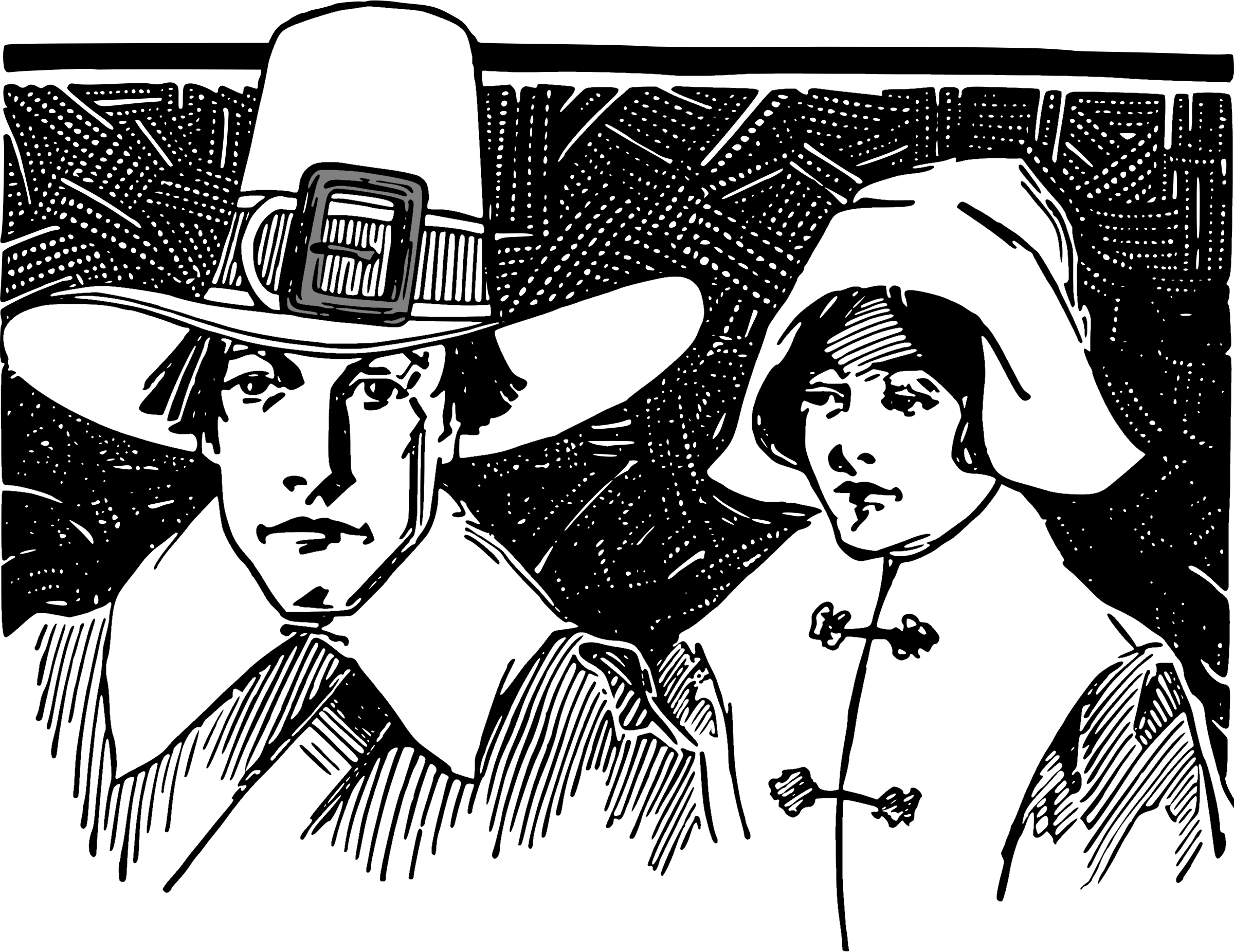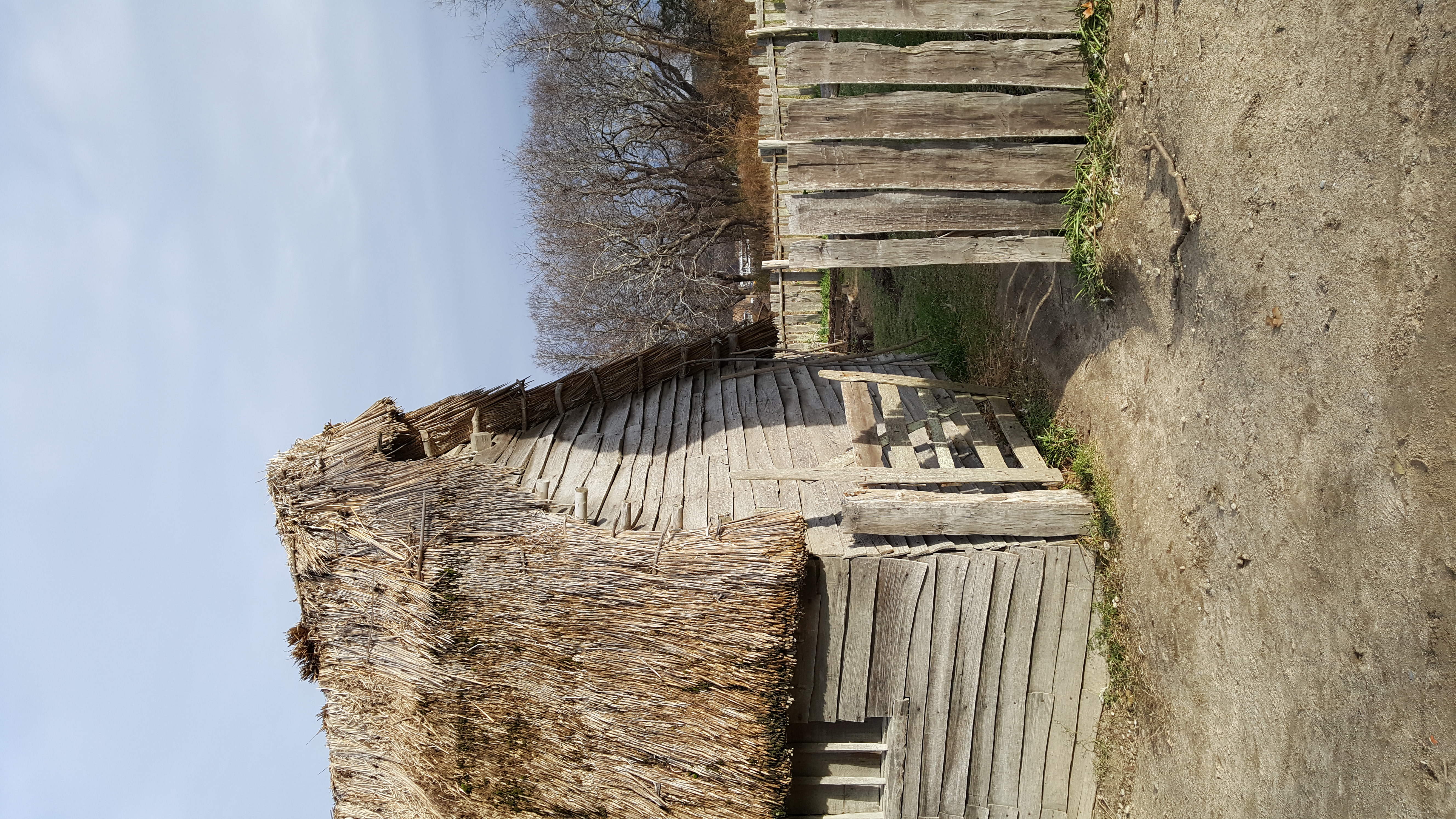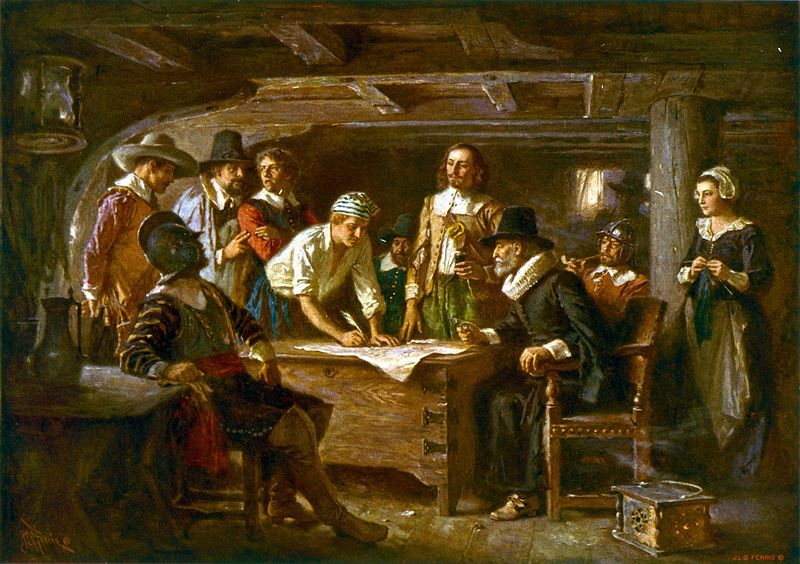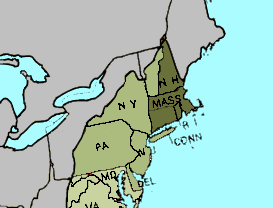Northern Colonies
New Hampshire
Massachusetts
Connecticut
Rhode Island
Fishing was more common in New England than in other colonies. There are many rivers there. Fishing villages got started and towns and cities grew out of them.
Puritan ways of life were a part of how some northern colonists lived. Puritans came to America to get away from the Church of England. Freedom of worship was important to them. They were strict about attending and obeying the laws of the church. Puritans wanted their children to be able to read the Bible. Those that broke the laws were put in the stocks.
At Plymouth Colony there were many Puritans. In 1620 there were 102 Pilgrims that came to America (many were Puritans). Less than half of them survived the first winter. The Mayflower went back to Europe the next year. Any who wanted to return could go back. Of the 50 that remained, none wanted to return. If half of the people died that first winter, why didn’t any want to return?

The Pilgrims had planned to settle just north of Jamestown. A charter was going to govern them. Instead, they set up their own government. When they arrived near Plymouth Rock, it was too late in the season to try to find Jamestown. They arrived in an area that was outside the authority of the Jamestown charter. Because they were in a new territory, they decided to set up their own government. They made and wrote the Mayflower Compact. They would rule themselves using the idea of majority rule. That means that what most of the people decide becomes the rule. An independent attitude was begun. It would help shape the ideas of a new nation.

Many other people in the colonies did not agree with the Puritan rules and laws. They wanted more rights. Other groups of people decided on their own rules and laws. The Massachusetts Bay Colony under Governor John Winthrop started other new colonies. Townships, or towns, put into place their own elected assemblies. Town meetings were held. They elected their own officials and started legislatures.
Some of the people moved to other places. Rhode Island became one of those other places. Roger Williams started the colony of Rhode Island. He worked to get more religious freedoms. He set up laws that kept the powers of churches separate from the government. People in Rhode Island had more religious freedom than they had in Massachusetts.
More and more trade and business came about. New towns and cities were created. The new places grew and expanded. Then colonists wanted laws that would help trade to keep growing.

Many towns started around a few key buildings. Mills were built on the streams and rivers. The faster streams and rivers in the north were good for mills. Towns grew up near these mills. Where there were towns and mills there was more need for people and machines. Many new things needed to be made. Town meetings were called and held as they were needed. Public schools were also set up. Massachusetts passed a law about building schools. If there were more than 50 families in a city they were to build schools with public taxes. Northern towns developed. They grew up closer and tighter together. A larger work force became available. Women also tended to be educated.

Reading resources
© Reading-SocialStudiesSolutions
Text Credits:
http://education-portal.com/academy/lesson/13-colonies-colonial-life-economics-politics.html;
Northern Colonies- Mayflower Compact, governments- http://www.ushistory.org/us/3b.as; The Writer’s Guide to Everyday Life in Colonial America by Dale Taylor, p. 40, Rhode Island p. 49;
Middle Colonies- New Jersey government- The Writer’s Guide to Everyday Life in Colonial America by Dale Taylor, p. 55; Pennsylvania colony (Freedoms);
The Extraordinary Suzy Wright: A Colonial Woman on the Frontier by Teri Kanefield, p. 9;
http://www.socialstudiesforkids.com/subjects/colonialtimes.htm;
Farmers- The Farmer by Wil Mara;
Women- The Extraordinary Suzy Wright: A Colonial Woman on the Frontier by Teri Kanefield, p. 14 (rights);
http://www.history.org/almanack/life/trades/traderural.cfm;
http://www.history.org/almanack/life/trades/traderural2.cfm;
http://www.ushistory.org/us/5e.asp;
http://www.usahistory.info/colonial/customs.html;
http://www.history.org/History/teaching/dayInTheLife/webactivities/dress/dress.cfm (Colonial dress);
Two Sets of clothes- The Writer’s Guide to Everyday Life in Colonial America by Dale Taylor pp. 254)
http://www.williamsburgkids.com/people/;
http://www.youtube.com/watch?v=ZeCXLiwWqKw (Making linen from flax);
http://www.ushistory.org/us/5a.asp;
http://www.ushistory.org/us/5b.asp;
http://www.history.org/kids/visitUs/colonialPeople/slave.cfm;
http://www.ushistory.org/us/1a.asp;
http://www.pbs.org/ktca/liberty/perspectives_daily.html#;
Abigail Adams by Kem Kapp Sawyer; DK Publishing 2009;
A Museum of Early American Tools by Eric Sloane;
http://www.foodtimeline.org/foodcolonial.html;
www2.census.gov/prod2/decennial/documents/00165897ch01.pdf- Population statistics;
Wool and Flax- The Writer’s Guide to Everyday Life in Colonial America by Dale Taylor pp. 252-253;
My Dearest Friend: Letters of Abigail and John Adams by Margaret A. Hogan and C. James Taylor p. 162
Plimoth Colony- https://www.plimoth.org/learn/just-kids/homework-help/mayflower-and-mayflower-compact;
Mayflower Compact- William Bradford, Of Plymouth Plantation, ed. Samuel Morison, 75-6
Image Credits:

Plimoth Plantation house and roof from Christie Allred from her visit there 2018-11-21 14.09.18;
Map of territorial growth 1775 by cg-realms from the National Atlas- Wikimedia Commons and by BNielsen- Openclipart.org;
Stocks 2 by Pearson-Scott-Foresman- Wikimedia Common;
Thanksgiving Pilgrims by J4p4n- Openclipart.org;
Watermill by IggyOblomov- Openclipart.org;
Mayflower in Plymouth Harbor by William Halsall - 1882 at Pilgrim Hall Museum - Plymouth-Massachusetts-USA-800px- Wikimedia Commons;
Mayflower Compact 1620 by Jean Leon Gerome Ferris through the Library of Congress cph.3g07155- Wikimedia Commons
Text Readability:
ATOS- 5.0
Flesch-Kincaid Level- 5.58
SMOG Index- 8.56
Notes:

The Mayflower voyage took 66 days. It departed from Plymouth, England on September 6, 1620 and arrived on November 11, 1620. Two attempts to make the trip were made earlier with a second ship, the Speedwell; however, the Speedwell had a leak and was left behind after a second unsuccessful attempt.
Two weeks after arriving at Cape Cod they chose a place to build their town. It was a place where the Wampanoag people had lived before. Sickness had killed off all but a few of that Native American tribe. During the days they would go ashore and work on building homes. At night they returned to the ship. That winter about half of their party died. When offered to return to England the following spring, none wanted to go back. One of the things they did was to make a compact or agreement to work together to form their government. They agreed to work for the common good of all. This agreement or pact was called the Mayflower Compact. Here is what the Mayflower Compact said:"In the name of God, Amen. We whose names are underwritten, the loyal subjects of our dread Sovereign Lord King James, by the Grace of God of Great Britain, France, and Ireland King, Defender of the Faith, etc. Having undertaken for the Glory of God and advancement of the Christian Faith and Honour of our King and Country, a Voyage to plant the First Colony in the Northern Parts of Virginia, do by these presents solemnly and mutually in the presence of God and one of another, Covenant and Combine ourselves together in a Civil Body Politic, for our better ordering and preservation and furtherance of the ends aforesaid; and by virtue hereof to enact, constitute and frame such just and equal Laws, Ordinances, Acts, Constitutions and Offices from time to time, as shall be thought most meet and convenient for the general good of the Colony, unto which we promise all due submission and obedience. In witness whereof we have hereunder subscribed our names at Cape Cod, the 11th of November, in the year of the reign of our Sovereign Lord King James, of England, France and Ireland the eighteenth, and of Scotland the fifty-fourth. Anno Domini 1620.”

